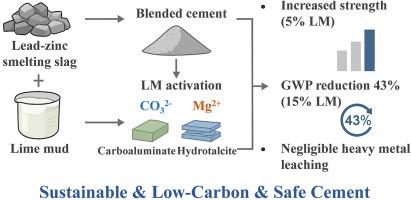Low-carbon cement development via synergistic use of lead–zinc smelting slag and magnesium-rich lime mud
IF 5.8
2区 化学
Q2 CHEMISTRY, MULTIDISCIPLINARY
引用次数: 0
Abstract
Lead-zinc smelting slag (LZSS) presents potential as a supplementary cementitious material (SCM); however, its limited intrinsic reactivity and detrimental influence on hydration restrict its widespread application. This study proposes a sustainable strategy for low-carbon cement development by incorporating magnesium-rich lime mud (LM), a by-product of industrial water treatment, to enhance the performance of LZSS-based cement. The influence of LM on cement hydration behavior, mechanical strength development, and phase evolution was comprehensively evaluated. Experimental results revealed that incorporating 5 wt% LM markedly improved compressive strength from early to later curing ages, primarily attributed to the alkaline activation of LZSS and the formation of beneficial hydration products such as carboaluminates and hydrotalcite. In contrast, a higher LM dosage (15 wt%) significantly reduced strength despite enhanced clinker hydration, indicating an optimal LM content threshold. Leaching tests, conducted under neutral water conditions, indicated negligible release of heavy metals from the blended cements, confirming their environmental safety. While hydrotalcite formation may improve resistance to chloride ingress, comprehensive durability evaluation is still needed. Additionally, carbon footprint analysis demonstrated a substantial reduction in the global warming potential (GWP) of the blended cements. Notably, the LM15 formulation achieved a GWP reduction of up to 43 % relative to ordinary Portland cement. These findings highlight the potential of co-utilizing LZSS and LM to improve cement performance, ensure environmental safety, and reduce carbon emissions, thereby advancing the development of low-carbon and resource-efficient cementitious materials.

铅锌冶炼渣与富镁石灰泥协同开发低碳水泥
铅锌冶炼渣(LZSS)具有作为补充胶凝材料(SCM)的潜力;但其固有反应性有限,对水化有不利影响,限制了其广泛应用。本研究提出了一种可持续的低碳水泥发展策略,即通过加入工业水处理副产物富镁石灰泥(LM)来提高lzss基水泥的性能。综合评价了LM对水泥水化行为、力学强度发展和物相演化的影响。实验结果表明,掺入5 wt% LM可显著提高LZSS从养护早期到后期的抗压强度,这主要归因于LZSS的碱性活化和有益水化产物(如碳铝酸盐和水滑石)的形成。相比之下,尽管熟料水化作用增强,但较高的LM用量(15 wt%)显著降低了强度,表明最佳LM含量阈值。在中性水条件下进行的浸出试验表明,混合水泥中重金属的释放可以忽略不计,证实了它们的环境安全性。虽然水滑石的形成可以提高对氯化物侵入的抵抗力,但仍然需要全面的耐久性评估。此外,碳足迹分析表明,混合水泥的全球变暖潜能值(GWP)大幅降低。值得注意的是,与普通硅酸盐水泥相比,LM15配方实现了高达43%的GWP降低。这些发现凸显了LZSS和LM在改善水泥性能、确保环境安全、减少碳排放方面的共同利用潜力,从而推动低碳和资源节能型胶凝材料的发展。
本文章由计算机程序翻译,如有差异,请以英文原文为准。
求助全文
约1分钟内获得全文
求助全文
来源期刊

Sustainable Chemistry and Pharmacy
Environmental Science-Pollution
CiteScore
8.20
自引率
6.70%
发文量
274
审稿时长
37 days
期刊介绍:
Sustainable Chemistry and Pharmacy publishes research that is related to chemistry, pharmacy and sustainability science in a forward oriented manner. It provides a unique forum for the publication of innovative research on the intersection and overlap of chemistry and pharmacy on the one hand and sustainability on the other hand. This includes contributions related to increasing sustainability of chemistry and pharmaceutical science and industries itself as well as their products in relation to the contribution of these to sustainability itself. As an interdisciplinary and transdisciplinary journal it addresses all sustainability related issues along the life cycle of chemical and pharmaceutical products form resource related topics until the end of life of products. This includes not only natural science based approaches and issues but also from humanities, social science and economics as far as they are dealing with sustainability related to chemistry and pharmacy. Sustainable Chemistry and Pharmacy aims at bridging between disciplines as well as developing and developed countries.
 求助内容:
求助内容: 应助结果提醒方式:
应助结果提醒方式:


